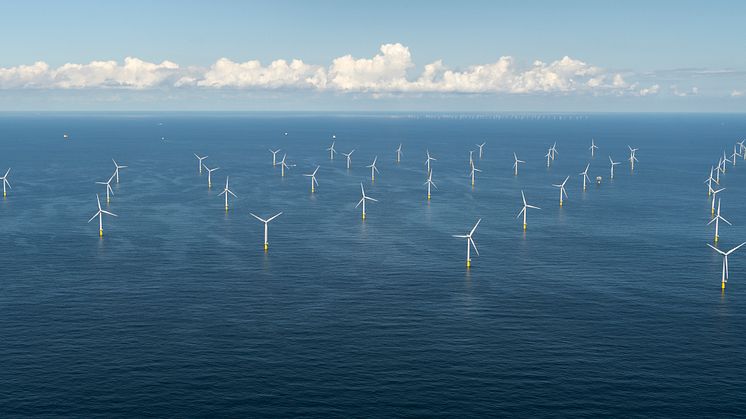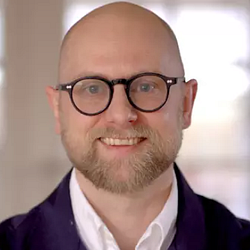
Pressemeddelelse -
The hydrogen wind turbine has potential - but there are still many unknown factors
Can hydrogen be produced directly at offshore wind turbines and thereby avoid loss of energy and reduce costs? Green Hydrogen Systems and partners have researched this in an innovation project. The results indicate that there are good possibilities, but more testing is needed, and at the same time there are a lot of unknown factors.
Hydrogen plays an important role in the green transition because it can be used directly as fuel or converted into, for example, methanol or ammonia, which can be used as green fuels for industry and heavy transport such as shipping.
Green hydrogen is produced through an electrolysis plant - among other things with electricity from offshore wind turbines. When hydrogen production is scaled up, it is part of the plan that the power from the offshore wind turbines must be transported through cables to an electrolysis plant on land. This process is both complex and expensive, and at the same time, there is a significant loss of energy associated with this. Therefore, together with several partners, Green Hydrogen Systems has researched the technical, safety and business possibilities in various setups in the innovation project "Offshore Hydrogen Wind Turbines". The project, financed by the Danish program, EUDP - Energy Technology Development and Demonstration Program, has investigated a setup where electrolysis plants are placed at each offshore wind turbine. They compare this setup to the solution where the electrolysis plant is located on the coast, and the electricity must be transported before it can be converted into hydrogen.
The technology is proven, but more work is needed
Combining electrolysis and offshore wind turbines is not without challenges. In the project, they have worked with pressurized alkaline electrolysis, because hydrogen under high pressure has the potential to be the most cost-effective. By creating a higher pressure in the electrolysis offshore, it will be hydrogen and not electricity that is sent ashore.
“Our approach to the project has been to investigate high-pressure electrolysis and avoid hydrogen compressors because it will provide a simpler setup. We have confirmed that there is a potential and we know that it is beneficial to convert electricity to hydrogen as early in the process as possible. We have found that it is technically possible to integrate electrolysis with the wind turbine, but we cannot yet conclude which solution is better. Several elements affect this business case, and more tests of pressurized alkaline electrolysis and more knowledge of the costs are needed,” Henrik Gøbel Füchtbauer, System Architect at Green Hydrogen Systems, says.
Safety must be considered from the beginning
Working with high pressure, electrolysis and hydrogen combined with offshore wind turbines is new territory. If it is not handled properly, it can become an explosive affair. That is why The Danish Institute of Fire and Security Technology (DBI) has been an important partner in the project.
“Safety is paramount when it comes to hydrogen production and hydrogen storage under high pressure. By connecting it to an offshore wind turbine, new factors come into play. Among other things, there is limited space next to an offshore wind turbine, and because these are new combinations, you must find out which ‘rules’ you have to follow, and which requirements apply. In the project, we have discovered challenges, and we have become smarter about what we need to find answers to concerning safety if the hydrogen turbine is to become a reality. One thing we are sure of is that it is essential to consider safety and documentation requirements early in the process of an innovation like this. Otherwise, you can run into major challenges when you think you have a fully developed product,” Aqqalu Ruge, who is Project Manager at The Danish Institute of Fire and Security Technology (DBI), says.
Valuable insight into a market with still many uncertainties
In the project, the partners have calculated the 'levelized cost of hydrogen' (LCoH) for a 1 GW wind farm. However, the outcome of the calculations on whether it is good economic business with hydrogen turbines is not clear. Because many unknown factors will be decisive. Such as the price of hydrogen and government regulations. However, according to the partners, the Offshore Hydrogen Wind Turbine project has contributed to more knowledge.
“Overall, we have gained a lot of knowledge from the project, that we did not have before. Converting to hydrogen requires a lot of development and investment. Above all, green energy and then hydrogen. We have come closer, and we - as partners in the project - have gained a greater understanding of the various industries. It is valuable learning when different systems must work together in a new field. There are high demands and many needs when discussing safety, wind turbines and electrolysis in one solution,” Henrik Gøbel Füchtbauer says.
Facts about Offshore Hydrogen Wind Turbines
The innovation project, Offshore Hydrogen Wind Turbines, which was completed in December 2023, has Green Hydrogen Systems, DBI - The Danish Institute of Fire and Security Technology, Aalborg University and Siemens Gamesa Renewable Energy as partners. Energy Cluster Denmark has facilitated the project, which is financed by the Energy Technology Development and Demonstration Program (EUDP).
For more information, contact:
Gitte Wad, Project Manager, Energy Cluster Denmark
Telephone: +45 3152 7516
Related links
Emner
Kategorier
Regions
Sammen gør vi Danmark til grøn førernation for innovative og globale energiløsninger.

